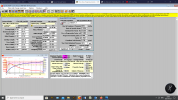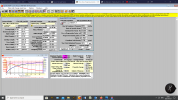I saw an example of this with my 300wsm. I had a 3 shot group with an ES 15 that printed with 2" vertical 4" over group at 600 yards. A higher charge I tested had an ES of 5 but the shot were spread out 13 14 inches verticaly. The velocities were quite a bit higher overall in that last group but not accurate despite good velocity. I saw this on a 6.5 saum once too. The tightest ES didn't have the best group at distance. Was it the harmonics? And bad timing? Thanks for the thoughts.OBT was mentioned and that is all about barrel time. Accurate nodes occur at intervals of 100 - 200fps depending on barrel length. The shorter the barrel the closer the nodes become.
The 223 is a good candidate to look at. With a 24 inch bolt rifle the highest safe node is close to 3250fps with our propellants and a 55gr Vmax. Pressure calculates at 50K psi in QL. Reducing the barrel to 22 inch the charge needs to be upped and node speed is again 3250 - 60fps. Pressure now increases to 55K psi. For a 20 inch barrel the speed is still close to 3250fps and pressure now at 60K psi.
Shorter barrels are more rigid than long ones and that helps reducing the effect of barrel harmonics. Thicker tubes have the same effect.
Nodes and harmonics are two different animals and occur simultaneously. Node position we can calculate whereas harmonics can not be pinpointed easily. Nodes are just a name conjured up to explain the position of the sound pressure pulse that effects the diameter and shape of the barrel when oscillating from the action to the muzzle. Accuracy nodes are longest and easier to use when the wave is at the knox of the barrel and has the least influence on the muzzle shape and diameter.
Shorter half nodes are found central between the major nodes, but temperature changes can reduce or speed up the bullet and take it out of the band of the node. Thus the shorter the bandwidth is, the easier temps will influence groups.
You are using an out of date browser. It may not display this or other websites correctly.
You should upgrade or use an alternative browser.
You should upgrade or use an alternative browser.
How does chopping a barrel alter velocity nodes?
- Thread starter steffen707
- Start date
 Help Support Long Range Hunting Forum
Help Support Long Range Hunting Forum
Hard rock
Well-Known Member
You can search for Chris Long and OBT to read his paper. He actually worked with Dan Newberry of OCW fame. Not the easiest read.
I've been following this subject for the last 11 years or so and believe there are numerous methods but it seems they all end up with similar loads. Lately I seen a proponant with a slightly different approach. I'm beginning to think that it has merit. His approach is to pick a charge that gives the velocity you want then vary the seating depth to tighten the group. I haven't tried it.
I personally use Dan's OCW method because it was the easiest method to employ on my range. Don't have to map shots at 300yds or set up a chronograph.
I asked that same question to my boss Glenn W Slade a big game hunter he was in the gun sales buisness friends with all the big names back then Roy weatherby Bill Carter and so on I loade his Finnbear Sako 16 in barrel 7Rem mag with nosler partitions his answer was so it doesn't get hung up on the cock pit when hunting Polar bearsThe bigger question here is why you would want a short barrel 7 RemMag.
Doom2
Well-Known Member
Maximum chamber pressure is a function of chamber volume and the first few inches of rifling in the barrel for any bullet /powder combination. The pressure decays as the bullet travels further down the barrel, hence the longer the barrel the lower the muzzle pressure as the bullet exits the muzzle.Care to explain?
itchytriggerfinger
Well-Known Member
- Joined
- May 4, 2010
- Messages
- 95
I'm lost as to how making a barrel shorter increases velocity or raises muzzle pressure. In my experience, my longest barrels are my fastest all else being equal.
It is dependent on the quantity and burn rate of the powder in said barrel length. If the barrel is too short and the bullet exits the muzzle too soon, you end up with unburnt powder and loss of pressure and velocity.
It is dependent on the quantity and burn rate of the powder in said barrel length. If the barrel is too short and the bullet exits the muzzle too soon, you end up with unburnt powder and loss of pressure and velocity.
BoltActionBrotherhood
Well-Known Member
Where did you get that? No one is saying a shorter barrel = more velocity. Definitely the oppositeI'm lost as to how making a barrel shorter increases velocity or raises muzzle pressure. In my experience, my longest barrels are my fastest all else being equal.
It is dependent on the quantity and burn rate of the powder in said barrel length. If the barrel is too short and the bullet exits the muzzle too soon, you end up with unburnt powder and loss of pressure and velocity.
BoltActionBrotherhood
Well-Known Member
Yes that is just harmonics, and you can usually fix that with your seating depth adjustments, or a barrel tuner.I saw an example of this with my 300wsm. I had a 3 shot group with an ES 15 that printed with 2" vertical 4" over group at 600 yards. A higher charge I tested had an ES of 5 but the shot were spread out 13 14 inches verticaly. The velocities were quite a bit higher overall in that last group but not accurate despite good velocity. I saw this on a 6.5 saum once too. The tightest ES didn't have the best group at distance. Was it the harmonics? And bad timing? Thanks for the thoughts.
itchytriggerfinger
Well-Known Member
- Joined
- May 4, 2010
- Messages
- 95
Maybe I misunderstood Doom2 statement that the longer the barrel the lower the muzzle pressure as the bullet exits. If powder is still burning or if pressure is still rising until peak, how is this true?
Also, cohunts statement about chopping off barrel increasing muzzle pressure seem contradictory to me also. I could see that being true only if you knew at exactly what point in the barrel the powder charge was completely consumed and stopped generating pressure, and that would have to happen well before the muzzle.
Or am I missing something?
I am not trying to be difficult, just trying to have a clear understanding of what's being stated.
Also, cohunts statement about chopping off barrel increasing muzzle pressure seem contradictory to me also. I could see that being true only if you knew at exactly what point in the barrel the powder charge was completely consumed and stopped generating pressure, and that would have to happen well before the muzzle.
Or am I missing something?
I am not trying to be difficult, just trying to have a clear understanding of what's being stated.
So maybe revisit the super high node with terrible vertical and do a seat depth test? The ES were fantastic on that one. It was so outa there on vertical I tossed it aside for the lower one that had very low vertical deviation. I think it was the nosler 168 ablr. I think 3190 FPS before I chopped the barrel off.Yes that is just harmonics, and you can usually fix that with your seating depth adjustments, or a barrel tuner.
BoltActionBrotherhood
Well-Known Member
Yeah thats what I would do, and we all are human and sometimes we through shots as well. Usually when its all over the place and the es is good, its the harmonics, and the barrel being at the top or bottom of a wave length per say.So maybe revisit the super high node with terrible vertical and do a seat depth test? The ES were fantastic on that one. It was so outa there on vertical I tossed it aside for the lower one that had very low vertical deviation. I think it was the nosler 168 ablr. I think 3190 FPS before I chopped the barrel off.
Tripodmvr7
Well-Known Member
See the calcs that I did in QL with a 24 and a 20 inch barrel. The muzzle pressure is shown in the right bottom window.Maybe I misunderstood Doom2 statement that the longer the barrel the lower the muzzle pressure as the bullet exits. If powder is still burning or if pressure is still rising until peak, how is this true?
Also, cohunts statement about chopping off barrel increasing muzzle pressure seem contradictory to me also. I could see that being true only if you knew at exactly what point in the barrel the powder charge was completely consumed and stopped generating pressure, and that would have to happen well before the muzzle.
Or am I missing something?
I am not trying to be difficult, just trying to have a clear understanding of what's being stated.
Attachments
Rflshootr
Well-Known Member
From what I'm seeing, 100% of the powder is burned in the 20" barrel. Is it the same using a slower powder, say like H4831 or Re-22 or maybe even H1000?See the calcs that I did in QL with a 24 and a 20 inch barrel. The muzzle pressure is shown in the right bottom window.
itchytriggerfinger
Well-Known Member
- Joined
- May 4, 2010
- Messages
- 95
From that data can you correlate at what point 100% of the powder is burned or when pressure is no longer generated?
I don't know much about all this doodley squat about nodes, but I cut my 6.5 SAUM down fo 20" from 24". It lost 80 fps and was just as accurate with the exact same load.
BoltActionBrotherhood
Well-Known Member
Alright guys, Just got back from the range with some testing 26inch barrel vs 16inch barrel same load same chamber.
bullet is the barnes 127
RL26-
26INCH=3162 FPS
16INCH= 2755
Velocity loss of 407fps
= 40.7 fps per inch with this powder. (SLOW burning powder)
RL-16-
26INCH=3078 FPS
16INCH= 2721
Velocity loss of 357fps
=35.7 Fps per inch
The velocity nodes and accuracy nodes did not correlate.
bullet is the barnes 127
RL26-
26INCH=3162 FPS
16INCH= 2755
Velocity loss of 407fps
= 40.7 fps per inch with this powder. (SLOW burning powder)
RL-16-
26INCH=3078 FPS
16INCH= 2721
Velocity loss of 357fps
=35.7 Fps per inch
The velocity nodes and accuracy nodes did not correlate.

